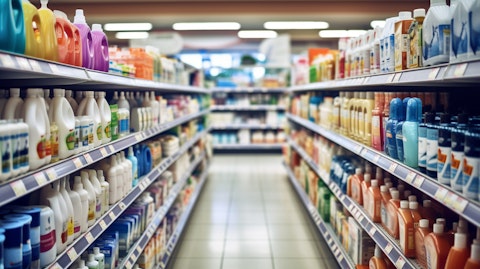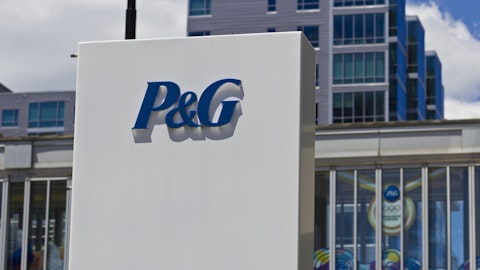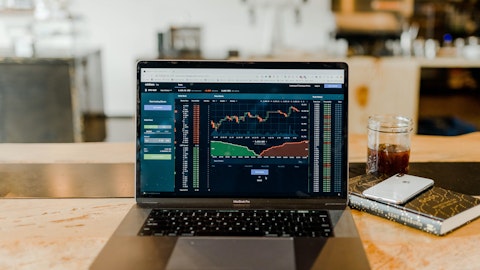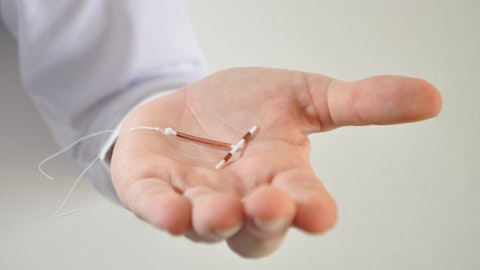Church & Dwight Co., Inc. (NYSE:CHD) Q3 2023 Earnings Call Transcript November 3, 2023
Church & Dwight Co., Inc. beats earnings expectations. Reported EPS is $0.74, expectations were $0.68.
Operator: Good morning, ladies and gentlemen, and welcome to Church & Dwight’s Third Quarter 2023 Earnings Conference Call. Before we begin, I have been asked to remind you that on this call, the company’s management may make forward-looking statements regarding, among other things, the company’s financial objectives and forecasts. These statements are subject to risks and uncertainties and other factors that are described in detail in the company’s SEC filings. I would now like to introduce your host for today’s call, Mr. Matt Farrell, President and Chief Executive Officer of Church & Dwight. Please go ahead, sir.
Matt Farrell: Thank you, operator. Good morning, everybody and thanks for joining us today. I’ll begin with a review of Q3 results, and then I’ll turn the call over to Rick Dierker, our CFO. And when Rick is wrapped up, we’ll open the call up for questions. So let’s begin. Q3 is the fourth consecutive quarter of solid results beginning with Q4 2022. Reported revenue was up 10.5%, which exceeded our 8% outlook. Organic revenue grew 4.8%, also exceeding our 4% outlook. It’s worthy of note that our global consumer business posted 5.8% organic growth, which exceeded our expectations. Going the other way, our SBD business accounted for one point of negative growth. Our gross margin expanded 270 basis points, and marketing as a percentage of sales increased 80 basis points to 11.5% of sales.
Adjusted EPS was $0.74, which is $0.8 higher than our $0.66 EPS outlook, and that result was driven by higher than expected sales growth and gross margin expansion. It’s important to call out the 2.7% positive volume growth in Q3. It’s the first in eight quarters, and our expectation is that positive volume growth will continue in Q4 to finish out the year. We continue to grow in the online class of trade. 17% of our global sales were purchased online in Q3, compared to 16% in the year ago quarter. Just a few comments on the economy. Unemployment remains low in the U.S., and in most of our major international markets. Unemployment is the stat that we closely watch. Regarding the health of the consumer, household balance sheets are more stretched as savings are lower, and credit card debt is higher.
Student loan payments are restarting. Mortgages and auto loans are more costly, why? Because of higher interest rates, and higher oil may lead to higher gasoline prices. So a higher cost environment leads to trade down. As consumers look for the best value, especially in our household categories, and we are well positioned for this trade down, given that 40% of our portfolio is value products. Now I’m going to comment on each business. First up is the U.S. The U.S. consumer business posted strong 5.5% organic sales growth, of which 3.6% was volume driven. Seven of our 14 power brands held or gained a market share in the quarter, and for context, the brands that grew share represent 65% of our U.S. sales. Private label is another stat that we closely watch.
The good news here is the weighted average private label market share in our categories is stable. Now I want to look at a few of the more important categories in the U.S., starting with laundry. ARM & HAMMER liquid laundry continues to see consumption growth driven, in part, by the continued trade down to value brands and by media support behind our new Give It The Hammer advertising campaign which celebrates the great value that ARM & HAMMER offers in tough economic times. ARM & HAMMER liquid laundry detergent held share in the quarter as a category grew 5%. We’re now at 14.3% share and XTRA, our extreme value offering, grew consumption 6.1% and increased market share to 3.8%. Regarding new products, we launched a new unit dose form of detergent, ARM & HAMMER Power Sheets laundry detergent as the first laundry detergent sheet from a major brand in the US, Power Sheets is a convenient new unit dose form of detergent that delivers an entirely new laundry experience.
It is mess free, it’s lightweight, and eliminates plastic bottle waste. While delivering the trusted ARM & HAMMER powerful cleaning performance that consumers have come to rely on and love. We launched the product online in August. In September, Power Sheets was the number one laundry detergent item during Amazon’s September Prime Day event. So we’re off to a great start with this innovation which will roll out even more broadly in 2024. Now Litter, ARM & HAMMER Litter also continues to perform extremely well with 11% growth outpacing the category which was up 8% and growing share to almost 25%. Consumers continue to choose ARM & HAMMER™ Litter offerings. We have steady demand for our premium litter offering which is a black box, but our orange box in particular is driving the growth as it offers a great value for the cost constrained cat owner.
Our new ARM & HAMMER Hardball lightweight clumping litter is off to a solid start as distribution expands in the lightweight segment where we are underrepresented today. Turning it out of personal care, our BATISTE grew consumption 14% in the quarter as we continue to build dry shampoo awareness and drive household penetration. The dry shampoo category and BATISTE have room to run as we continue to invest to build awareness in dry trial, especially through sampling. HERO which was acquired last October, captured the number one market share position in the total acne treatment category. In the acne patch subcategory, MIGHTY PATCH is over 50% share. Retail distribution continues to grow and we still have room to run as we expand across all classes of trade.
The HERO team is doing a spectacular job growing this business. There continues to be a great deal of buzz here at Church & Dwight around the HERO brand and its future growth potential. Similarly, THERABREATH, which was acquired in 2021, is performing extremely well and has been gaining share at a rapid pace. In Q3, THERABREATH took over the number one share position in the non-alcohol segment with almost a 29% share. Distribution of THERABREATH has more than doubled since the acquisition date, and we expect this brand to be a long-term grower for Church & Dwight. Regarding a couple of businesses that depressed our results last year, WATERPIK continues to stabilize with Q3 coming in close to plan similar to Q2. WATERPIK all channel consumption, actually was up slightly in Q3.
Turning to gummy vitamins, while the VITAFUSION was close to our expectations in the first half, our consumption was down 11% in Q3, partly due to distribution losses at many retailers due to our supply issues in 2022. And our job now is to win back retailer confidence and then regain lapsed consumers. Next up is International. Our International team is doing a great job delivering organic sales growth of 7.3% in Q3, driven by broad-based growth in most of our subsidiaries and our global markets group. Volume contributed 2.3% of the growth, and this was led by STERIMAR in Nasal Hygiene, and OXICLEAN. Both STERIMAR and HERO are gaining distribution across our international markets, and we expect more to follow. And finally, especially products.

Organic sales decreased 10%. But this is largely due to one product line called MEGALAC, which is being hurt by inexpensive imports. Excluding MEGALAC, the remainder of SPD delivered positive growth of 2%. I’m going to wrap up by saying we just closed out a strong October, and we expect positive volume growth for a second consecutive quarter in Q4. We raised our reported sales outlook to reflect the strength of consumer demand for our products while maintaining our full year EPS outlook. Now when we are performing well going into the fourth quarter, it’s an opportunity to invest in the business. This is a long-standing practice of reinvestment at Church & Dwight and is well understood by long-term shareholders. We take a long view with respect to the health of the business.
Our business model is working. Our value offerings are performing well as are our premium offerings. Innovative new products are contributing to our growth and we have one of our best new product lineups coming in 2024. Acquisitions are on track and significant cash generation positions us to continue to add TSR-accretive brands to our portfolio. And now I’m going to turn it over to Rick to give you some color around Q3 and the full year and the investments we’ll be making at Q4.
Rick Dierker : All right, thank you Matt. And good morning, everybody. We’ll start with EPS. Third quarter adjusted EPS was at $0.74 down 2.6% to the prior year. As Matt mentioned the $0.74 was better than our $0.56 outlook primarily due to higher than expected sales growth and gross margin expansion. Net sales were up 10.5% and organic sales were up 4.8%. Over half of our organic growth in the quarter was driven by volume. The total consumer business was up 5.8% organically. Our third quarter gross margin was 44.4%, a 270 basis point increase from year ago primarily due to improved pricing, volume, productivity and the impact of the HERO acquisition net of the impact of higher manufacturing costs. Let me walk you through the Q3 bridge.
Gross margin was made up the following. Positive 140 basis points impact from price volume mix. Positive 120 basis points from acquisitions and a positive 160 basis point impact from productivity, partially offset by a drag of 150 basis points due to inflation. Moving to marketing. Marketing was $27 million up year-over-year. Marketing expense as a percentage of sales was 11.5% or 80 basis points higher than Q3 of last year. For SG&A, Q3 adjusted SG&A increased 310 basis points year-to-year, primarily due to higher incentive comp, improved business performance, SG&A related to the HERO acquisition, and investment spending. Other expense, all-in, was $21.8 million, a $2.4 million increase due to higher average interest rates. For the full year, we now expect other expense of approximately $95 million.
For income tax, our effective rate for the quarter was 24.1%, compared to 20.2% in 2022, an increase of 390 basis points as the prior year rate included the benefit of a non-recurring state tax reduction. We continue to expect the full year rate to be approximately 22%. And now to cash. For the first nine months of 2023, cash from operating activities was $795 million, an increase of $261 million due to higher cash earnings, including the positive impact from recent acquisitions, and improvements in working capital. Turning to the full year outlook, We now expect the full year 2023 reported sales growth to be approximately 9%, up from our previous outlook of 8%. We continue to expect organic sales growth to be approximately 5%. We now expect full year reported gross margin to expand 210 basis points up from 200 basis points.
This is an encouraging trend as we continue to move closer to restoring gross margins to pre-COVID levels. We continue to expect a double digit percentage increase in gross profit in full year 2023. Looking at inflation, we continue to expect around $120 million of higher manufacturing costs in 2023. This is well below what we have experienced in the last couple of years. While many commodity prices remain below prior year levels, resins and oil based commodities are a bit higher. We continue to expect full year marketing as a percent of sales to be 11%. And we continue to expect full year SG&A to be higher in both dollars and as a percent of sales compared to 2022. SG&A is expected to be higher than our previous outlook driven by incremental R&D investments, higher incentive compensation given our strong performance and a bad debt reserve related to one specific customer situation.
As in past years when we have strong business performance, we invest for the future. Our investments will focus on driving future growth with higher marketing dollar investment, R&D investment, including clinical studies and accelerating product registrations in international markets, as well as driving efficiency, including investments in automation and technology. We continue to expect full year adjusted EPS growth to be approximately 6%. And as a reminder, our EPS guidance includes the step up of marketing that we’ve been talking about and higher SG&A. We continue to expect full year cash flow from operations to be approximately $1 billion. Our full year CapEx plan is now expected to be approximately $230 million as we continue to make capacity investments.
And we expect to return to historical levels of CapEx about 2% of sales by 2025. Moving on to Q4, we have a strong outlook and expect reported sales growth of 5% and approximately 4% for organic with volume contributing 1% or better. Organic growth rate in Q4 reflects positives from HERO, Litter and THERABREATH and negatives from not repeating some low margin laundry promotions. We expect gross margin expansion, a significant increase year-to-year in both marketing and SG&A, and marketing is expected to be an excess of 14% in Q4. Adjusted EPS is expected to be $0.53 per share, a 2% increase from last year. So to summarize a strong nine months of the year behind us, we saw the inflection point of volume growth as expected and we are spending on marketing and investments to build momentum for 2024 and beyond.
With that Matt and I would be happy to take questions.
See also 11 Best Oil Refinery Stocks To Buy and 13 Cash-Rich Dividend Stocks To Buy Now.
Q&A Session
Follow Church & Dwight Co Inc (NYSE:CHD)
Follow Church & Dwight Co Inc (NYSE:CHD)
Operator: [Operator Instructions] Your first question comes from Rupesh Parikh from Oppenheimer.
Rupesh Parikh: Good morning and thanks for taking my question. So just starting with the specialty product segment, how do you think about the business in the coming quarters? So this quarter obviously a larger decline. Just wanted to get a sense of we should see weakness for a few more quarters until you lock the issue that you cited.
Matt Farrell: Yes. It’s going to be a, Rupesh, it’s going to be a drag again in Q4. So when Rick calls a 4% number for organic for Q4 that’s a net of SBD which kind of reduces the contribution from the consumer business. But so yes at least one more quarter where we’re going to be down maybe in Q1 as well.
Rick Dierker : Yes, I think the nuance, Rupesh, also is when you look at like a 4% growth rate in Q4. When we talk about investing many times we talk about SG&A or marketing, sometimes we’re doing really well. We also look at customer profitability. We take — we get ahead of it and call unprofitable or low profit promotions in some of our businesses like laundry.
Rupesh Parikh: Great. That’s a good segue to our next question. So organic sales growth was maintained for the full year. So it sounds like those lower margin laundry promotions is what may have limited that organic sales growth increase for the full year. Is that correct or is there anything else weighing on? A lot of organic —
Matt Farrell: No, that’s true. Last year in the fourth quarter we had a looking back now, we had a lot of promotions that we thought were not profitable. So we called them. So they’re not going to be in place for this fourth quarter, which obviously results in a lower volume.
Rupesh Parikh: Great. Maybe just a follow-up. Just relate to that. Is there a way to quantify the impact of the lack of running those promotions?
Matt Farrell: The user to do that when the quarter is over than do right now. Now it’s more conjecture, but it is a direct.
Operator: The next question comes from Bill Chappell from Truist Securities.
Bill Chappell: Thanks. Good morning. Can you talk a little bit about kind of where we are for both HERO and THERABREATH in terms of as we’re moving into next year trying to understand the distribution? Is it where you expect to be or we have tougher comps for both of those businesses in terms of growth in year two?
Matt Farrell: Remember, in year one, we’ll say it’s 2023, when we were gaining distribution was throughout the year. So we’ll have full year benefit. All the distribution gains in 2024 versus ‘23. So that’s a positive. So naturally, the comps are more difficult once you’ve got it in place. But the demand for the product is surprising us. In fact, the demand has been exceptional wherever we’ve launched it. The second thing is we’ll be launching HERO in dozens of countries next year through our global markets group. And that will happen throughout the year so that’s not a Jan one thing, but see a lot of opportunity there as well. Now THERABREATH, THERABREATH was acquired in December of 2021. And they have far more distribution already than HERO did when we acquired THERABREATH.
We did expand that in 2022, but I’d say 2023 versus 2022 is less benefit from distribution gains in comparison to HERO. What’s happening is because the demand for THERABREATH and the consumers voting in favor of THERABREATH, what’s happening is retailers are willing to give us more shelf space. And we fully expect to get more shelf space when the resets happen in 2024.
Rick Dierker : Yes, Bill, that’s the big difference for 2024. In 2023, we got TDPs. We got new retailers, new stores. Now it’s all about shelf space and expanding that footprint. And that’s what’s happening.
Bill Chappell: Got it. And then, second, just kind of trying to understand the spend or the accelerated spin in 4Q to kind of keep your EPS guidance in check. Is that more SG&A because it does sound like you’ll have some year-to-year benefit on gross margin by just pulling back on some of the promotions. Or is there a, will it be SG&A and gross profit in terms of kind of how you’re trying to reinvest in business to keep things going in ‘24?
Rick Dierker : Yes, Bill, it’s mostly SG&A. It’s, some of it’s higher incentive comp, but many of it is the investments we’ve talked about these last few quarters and just more of that. I think HERO is a good example. As we fast forward product registrations, we’re going to be in 40, 50 new countries pretty rapidly because we’re able to do that. So we think all these investments are great and they’re going to help us in 2024 and beyond.
Operator: The next question comes from Chris Carey at Wells Fargo Securities.
Chris Carey: Hey guys, one quick follow up on laundry and then broader question. The promotions that you’re talking about, have that been occurring over the course of the year or was that something new that you did because you’re responding to the environment or you saw an opportunity because you’re tracking ahead? I’m trying to understand if we’re slopping something or this is a new decision. Apologies, you should understand but –.
Matt Farrell: These are promotions that happened in Q4 ‘22 that didn’t happen in Q3 or Q2 ‘22. So there was isolated to Q4 last year and the decision to pull back on those is because we can. And besides like I said earlier, there weren’t the best payback. So we said it’s a good time not to repeat them.
Chris Carey: Okay, that makes sense. I know we’ll get guidance on 2024, next quarter, but you have given kind of high level thoughts. As they think about this, volumes positive, you still have gross margin, momentum behind productivity, inflation is easing. I think you’ve kind of taken a view on that and you’ve rebased investment spending this year. Is there anything that we should be just thinking about, perhaps less obvious, going into next year, and just maybe any kind of like high level thoughts about how you feel about the business and your momentum going to 2024? Thanks.





